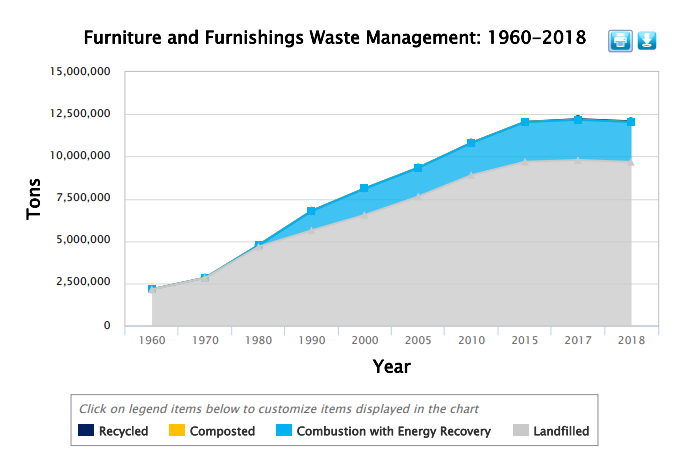Rheaply is continuing our guest blog series! We’re inviting contributors from the world of sustainability and circularity to share their thoughts, opinions, and hopes for the future of the industry.
This article comes from our friend Kriss Kokoefer, President and Owner at Kay Chesterfield, Inc.
Each year Americans throw out more than 12 million tons of furniture, creating mountains of solid waste that have grown 450 percent since 1960. The Environmental Protection Agency (EPA) estimates that a staggering 98% of newly produced American furniture will end up in landfill.

Commercial furniture waste
There are many factors at play here. For one, furniture lifespan is shorter. Cheaper materials, lower-quality builds, and trendy designs have caused furniture waste to sky-rocket.
In the commercial furniture industry, however, pieces are still built to a high standard, designed to withstand wear and tear from constant usage. Unfortunately, commercial building leases are typically only 5-10 years, and because there has not been an efficient way to donate or sell used office furniture, many of these pieces go to landfill long before their potential life span ends.
Our approach to commercial furniture
Here at Kay Chesterfield, we are taking a strategic approach to our industry’s waste, focusing on refurbishment of commercial furniture only, as we believe this is where we can have the most impact.
We aim to make it as easy as possible for designers and dealers to repurpose furniture with reupholstery, refinishing, and textile cleaning.
Instead of the typical mom-and-pop workshop model, we visualize a professional services / workshop hybrid model where clients work closely with project managers who are experts in both refurbishment techniques and the logistics of large-scale commercial projects.
Addressing industry-wide challenges
Changing the status-quo of the commercial furniture industry isn’t easy. Our business faces a number of challenges, that many others may be able to relate to. We want to educate our community about some stumbling blocks we are facing:
- Cost: There’s no way around it – reupholstery is expensive. Although it can be up to 40% less than buying new, it can also sometimes be as expensive as buying new. Our projects require human touch and attention to detail. We don’t work on an assembly line. Reupholstery involves the extra step of removing the old fabric. All of these factors add to the cost of a project.
- Talent pool: Without the development of formal apprenticeship programs, the pool of skilled reupholstery artisans continues to dwindle. Keeping our workrooms staffed is a challenge. We need to be able to offer enticing pay that continues to attract people to the trade.
- Status quo: Designers, dealers, and project managers are often taught to start fresh. There is value to revitalizing upholstery instead of purchasing new, but there needs to be more education about this method.
Benefits of commercial furniture reuse
Even with the challenges stated above, there are many benefits to working with reupholsterers instead of purchasing new. Mebl, a leader in furniture sustainability, reports that it takes 80% less carbon to reupholster than purchase the same lounge chair new.
Additionally, reupholstery has a faster lead time – new furniture tends to have longer manufacturing and shipping timeline. There is also greater fabric selection and ability to customize. New fabric makes a HUGE difference in a space!
- Organizations that choose reupholstery have the option to utilize the story of reuse in their own marketing.
- Keeping furniture out of landfills has a long list of environmental benefits, including less dangerous chemicals like methane in the air.
- Disposing of furniture is a cost in and of itself, not to mention the sunken cost of throwing away furniture.
Help us bring sustainability to commercial furniture
Companies like Rheaply are helping businesses scale reuse of furniture, fixtures, equipment, and much more. With the Right to Repair Act taking effect on July 1, 2024 in the State of California, the growing tide behind reuse is strong. Here’s how you might be able to push this movement farther in your own role:
- Ask (insist!) that sustainability solutions are not cut from project packages.
- Specify durable furniture that is designed for reupholstery and be prepared to justify better quality furniture to your clients.
- Think about the life-cycle of furniture before purchasing or specifying – is this piece of furniture a good candidate for reupholstery?
- Advise clients to implement a textile cleaning program. Regular and proper textile cleaning keeps a piece of furniture looking good for up to 4 more years than without proper care
- Adopt the right mindset – any excessive waste generated by a furniture product should be considered a design flaw
- Ask (insist!) that manufacturers design with reupholstery and/or slipcovers in mind
Making the furniture industry more sustainable is going to require participation from all of us to gain traction and momentum. We believe that reupholstery, refinishing and cleaning can have a huge impact but we need your help to spread the word. We ask you to keep these tips in mind when beginning your next project!
